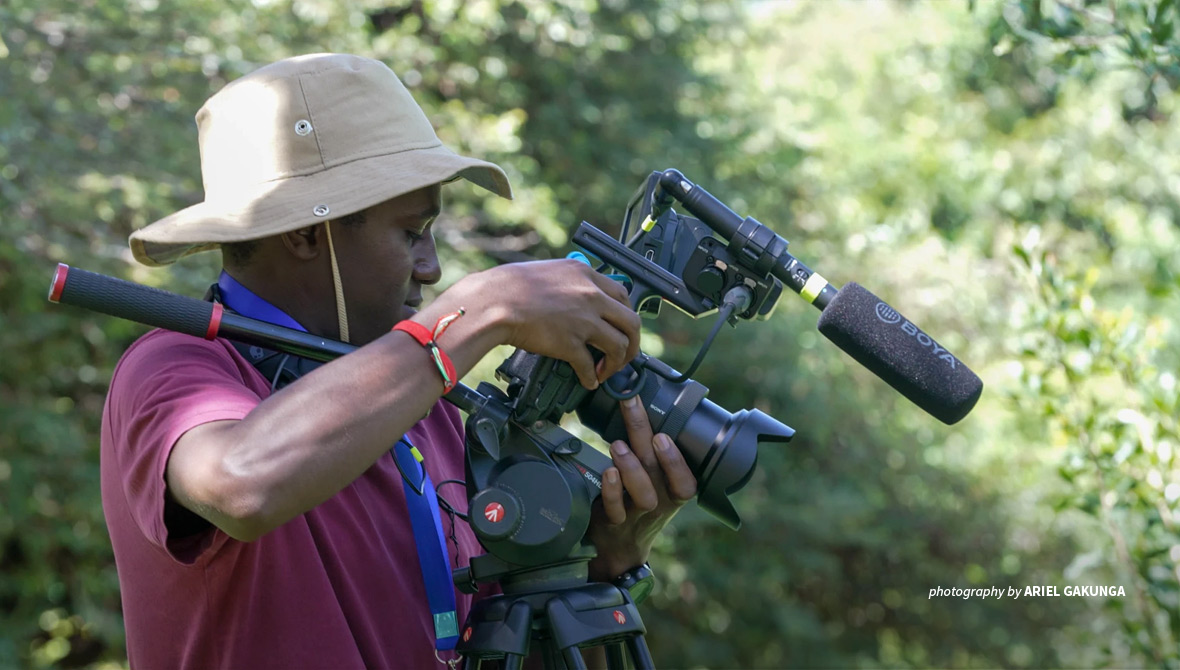Why we need more films about conservation science

African Conservation Voices fellow Samuel Thuku Kamau produced a film about a scientist helping conserve vultures in the Maasai Mara
Lemein Par is the only raptor biologist in Kenya’s Maasai Mara landscape. The film “Saving the Vultures: One Man’s Quest” shows his tireless efforts to conserve a disregarded, but threatened African wildlife species. Likewise, “Chasing the Golden Monkey” highlights the work of Deogratias Tuyisingize, who grew up near the Volcanoes National Park and is now studying a lesser-known primate in the Virunga landscape.
In partnership with Jackson Wild, African Wildlife Foundation (AWF) produced both short films through the African Conservation Voices (ACV) Media Labs. They are among six films centering the perspectives of African people and filmed by storytellers from Kenya and Rwanda as part of a year-long training and mentorship program.
Vultures are unsung heroes of the Maasai Mara’s ecosystem
“Saving the Vulture: One Man’s Quest” opens with a young man attending to a distress call and jumping in his car to respond to an incident. He is raptor biologist Lemein Par, who studies and helps conserve the Maasai Mara landscape’s birds of prey, attending to issues like the accidental death of vultures feeding on carcasses intended to poison lions that attack livestock.
ACV fellows Rachel Wambui and Samuel Thuku Kamau run the end-to-end process of producing the film, wearing several hats in the process. They spotlight a Maasai scientist while exploring an unlikely casualty of human-wildlife conflict. Lemein addresses vulture poisonings by cleaning up the site and rehabilitating surviving vultures in Naivasha.
“Watching how Lemein lit up when he started talking about vultures was so fascinating,” pondered Wambui. She added that in conservation stories, “we are not used to seeing people from the community being cast as ‘the scientist’.”
Additionally, Lemein monitors birds of prey habitats, targeting various vulture and eagle species found in the Maasai Mara landscape, some of which are critically endangered. Closing with a reminder of vultures' important role in maintaining healthy ecosystems by disposing of decomposing carcasses, the film is a chilling reminder of the complexities of conservation.
She was equally drawn to the vulture as a wildlife species typically kept out of the limelight, with nature documentaries focusing instead on iconic wildlife like elephants, rhinos, or lions. “We get removed from the fact that every species is important in the ecosystem. It was important to put the lens on the vulture and its significance in the natural system,” said Wambui.
Saving the future of the endangered golden monkey
In “Chasing the Golden Monkey,” produced, directed, filmed, written, and edited by ACV fellows Fiston Ishimwe, Raymond Tiff Kalisa, David Kwizera, Nailla Simbi, scientist Deogratias Tuyisingize joyfully recounts how he came to study the golden monkey, an endangered primate species.
Growing up near Volcanoes National Park, Deogratias (Deo) was in awe of the afromontane ecosystem and sought to participate in conservation. “I first came [to the park] as an intern and I was looking for a species that has never been part of studies.” He soon found that the golden monkey is the only primate species other than the mountain gorilla found in the protected area, and is found only in the Virunga mountains.
Golden monkeys are elusive — Deo spent many hours in the Volcanoes National Park as the primates habituated to the researchers. Eventually, they were able to observe golden monkeys at close range, collecting critical data on their charismatic appearance, unique behaviors, and bamboo-heavy diet.
ACV fellow Kwizeri noted that Deo’s dedication to “step in and do something” to save an endangered African wildlife species inspired him to make the film. “He has given back life to these primates,” said the filmmaker.
But Deo’s job as a primate researcher and conservationist does not end here. “Chasing the Golden Monkeys” depicts a central aspect of Rwanda’s successful conservation strategies: community engagement. In the film, he explains that sensitizing local communities on the importance of protecting the forest habitats and revenue-sharing mechanisms from wildlife tourism contribute to local development and conservation.
“Deo is a perfect example of filling the gap between conservation and science. He is the right person to learn from,” ACV fellow Ishimwe noted. The filmmaker aims to bridge this seeming divide through storytelling. “The ACV program has opened my eyes to the millions of stories on the ground,” he said, adding that he intends to use the newly made connections with other filmmakers, photographers, and editors to center African voices and perspectives in conservation stories and action.
Following a successful pilot in Kenya and Rwanda, AWF is going to expand the program to more countries in Africa in a bid to reach more storytellers as well as stories from the landscapes we work. This next phase will be announced in the next few weeks with a call for applications.